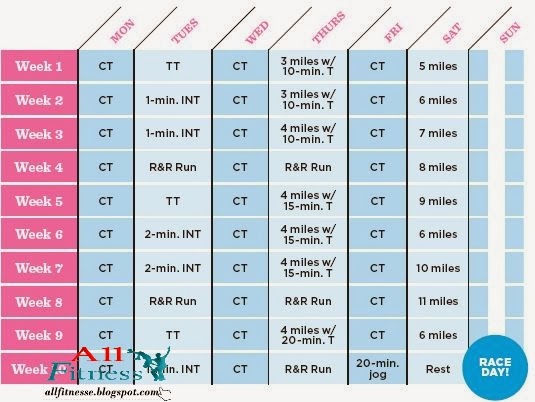10 Weeks to a Half- Marathon
10 Weeks to a Half- Marathon
Whether you’re a treadmill trotter or a road warrior, this
training plan will get you across the finish line. Designed by Kim Maxwell, a
USA Track and Field coach and personal trainer in Minneapolis-St. Paul, this
program won’t make you drop everything for running. You’ll log miles three days
a week, cross-train three days a week, and rest the remaining day. The running workouts
are focused and efficient, and because they’re limited, your legs and head will
stay fresh, making it less likely you’ll become injured or burned out. If
you’re a newbie, don’t hesitate to mix walk breaks into your runs (for example,
run two to three minutes, then walk 30 to 60 seconds ). “What’s important is
that you’re moving forward—it doesn’t matter if it’s walking or running,” says Maxwell. To all
runners: Listen to your body. Add an extra rest day or take an additional
cross-training day when you need it.
Do 30 minutes. Pick an activity that
elevates your heart rate, such as biking, swimming,
power walking, or using the elliptical.
TT: TIME TRIAL
Warm up for one mile, running at a very
easy pace. Then time yourself at a comfortably
fast pace (not all out) for two miles.
Note your time and try to beat it at your
next time trial.
R&R RUN: REST
& RECOVERY RUN
Run three to four miles at an easy pace. Every fourth
week will be for recovery—a rejuvenating time to scale back intensity.
INT: INTERVALS,
3.5 MILES
Run one mile easy, then for the next two miles, alternate either one minute of harder effort with one minute of easy recovery jogging or two minutes of harder effort with one minute of
jogging. Cool down with half a mile at an
easy pace.
T: TEMPO
RUNS, 3–4 MILES
Get ready to pick up the pace (you can talk, but no more than a few words at a time) for a portion of your workout.
Do one mile at your normal pace, then add the tempo somewhere in the middle. Finish at your normal pace.
PUT YOUR BEST
FOOT FORWARD
You’ve logged the miles and worked your butt off (or
at least tightened it up). Now it’s time to own this thing. Virginia Brophy Achman,
executive director of Twin Cities In Motion, a race series in Minneapolis, offers
tips to help you start and finish strong.
READ BEFORE YOU RUN. Review
the race materials, whether it’s a participant guide
e-mailed to you or details on the race’s website.
When you know in advance where you can drop your gear
on race morning, which miles have
water stations, and where the hills are on the course,
you’ll feel prepared and relaxed.
OUT WITH THE NEW. “Stick with
your normal routine,” says Brophy Achman. “Don’t wear
anything new, and don’t eat
anything different the night before, morning of, or during
your race.”
The tried-and true that worked for your training runs is your best bet to help you avoid issues like chafing, blisters, and GI distress.
PICK YOUR PACE.
Line up with people who run at your approximate speed
(look for pace signs at bigger races) so you don’t get jostled by or impede
speedsters. You may be able to race at a slightly faster pace than you trained
at, but don’t expect to suddenly fly.
When in doubt, play it safe and head toward the back of th
e pack.
CONTROL YOUR INNER RABBIT.
“Going out too fast is the biggest pitfall for any
runner,” says Brophy Achman. “It leaves you
without enough gas in your tank to finish strong.”
Adrenaline will fire you up and tempt you to surge
ahead. But 13.1 miles is no short trip, so consciously try to slow your roll.
RUN YOUR OWN RACE. If the race
is chip timed (you have a little electronic doodad on
the back of your race number or attached to your shoelaces), you’ll get your
accurate net time—how long it takes you to go from start to finish.
So even if you’re in the Porta-Potty when the starting
gun goes off, your clock doesn’t begin ticking until you cross the starting
line.
KEEP MOVING.
Don’t come to a sudden halt at a water stop—you’ll
cause a pileup behind you, plus your muscles will stiffen. Instead, run to the
second or third table (to avoid the crowds hitting
the very first one).
Listen to what the volunteers are yelling (like
“water” versus “Gatorade”), and point at a
volunteer to let him know you’re coming in for one of
his cups. Then walk as you sip.
TREK ON. After
you cross the finish, you’re spent, yes, but sitting
down immediately will hurt your recovery. Stroll along slowly to let your heart
rate and blood flow regulate as you refuel and revel
in
what you’ve just accomplished. All Fitness ___ 10 Weeks to a Half- Marathon












No comments